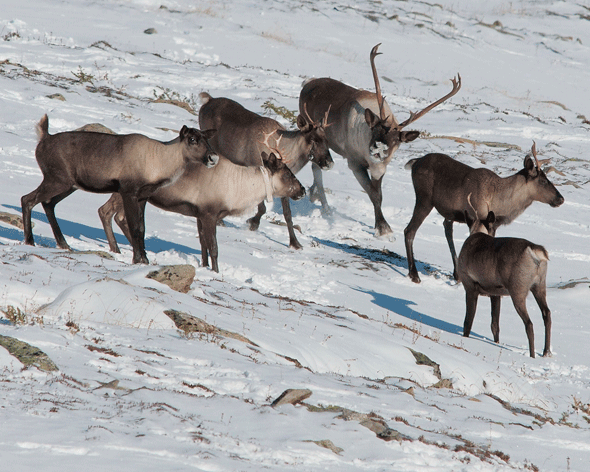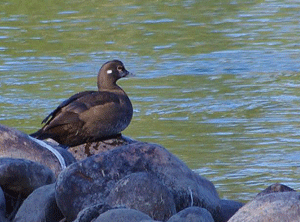Backgrounder
Jasper National Park
Ecological Integrity in the Maligne Valley
 Woodland Caribou © Mark Bradley
Woodland Caribou © Mark BradleyWhat’s being protected?
The Maligne Valley is home to a number of sensitive species, including woodland caribou, grizzly bears, Harlequin Ducks and black swifts. Although Parks Canada protects all native plants and animals to ensure ecosystem health, three species are of particular concern in the Maligne Valley: woodland caribou, grizzly bears and harlequin ducks.
Woodland Caribou
Jasper National Park protects part of the Southern Mountain population of Woodland Caribou, which has been listed as threatened under the Species at Risk Act. There are four herds in the park; the herd that lives in the Maligne Valley is the smallest, numbering six animals. The future of these six caribou is the most pressing conservation issue in the Maligne Valley.
The Maligne herd was larger historically. It declined from at least 68 animals in 1998 to 30 by fall 2003. Several initiatives were implemented in the mid-2000’s to reverse this trend (e.g. discontinuing track setting at Maligne Lake, developing flight guidelines), however the population has continued to decline.
Five threats to the caribou have been identified and are the focus of management actions:
- Altered predator/prey dynamics—the result of high historic elk and wolf populations
- Facilitated predator access into caribou habitat, which has made it easier for wolves to travel into caribou habitat in winter
- Direct human disturbance of caribou (e.g. road mortality, aircraft overflights)
- Loss of caribou habitat, which could result if a wildfire occurred
- Small population effects (species with small populations are more vulnerable to inbreeding, diseases and catastrophic events)
 Grizzly Bears © Mark Bradley
Grizzly Bears © Mark Bradley
Grizzly Bears
The grizzly bear is a COSEWIC-listed species of Special Concern. It is estimated that between 5 and 10 grizzly bears use the valley every year. Human-caused mortality, displacement and habituation are key threats facing grizzly bears in the mountain national parks.
Human-caused mortality occurs when bears are killed on park roads or the railway or are destroyed because they come into conflict with people.
Grizzly bears need large areas where they can forage and meet other life requirements relatively undisturbed by people. The ability to move freely between areas of high quality habitat is also critical for the long-term survival of bears and many other species.
Habituation is a term used to describe bears that have lost their natural wariness of people. Habituated bears face a higher risk of human-caused mortality; they are more likely to be killed on roads and railways.
 Harlequin duck © Kevin Gedling
Harlequin duck © Kevin Gedling
Harlequin ducks
The Harlequin Duck is listed as a sensitive species in Alberta and yellow-listed British Columbia. These ducks are sensitive to in-stream disturbance and pre-nesting foraging by females is critical to reproductive success. Interrupted feeding may result in population declines. As a result, Parks Canada has closed the mid-Maligne River to all commercial and public watercraft use.
New proposals for use of the mid-Maligne River must be scientifically defensible based on the well-documented aspects of Harlequin Duck ecology that led to the original precautionary closure, and enjoy broad-based public support.
What’s working well?
There has been no human-caused mortality of a grizzly bear in the Maligne Valley since 1995.
A large proportion of grizzly bear habitat in the Maligne Valley (80 to 81%) is secure. Although the valley is busy during peak season, there are quieter times and places where grizzly bears can access high quality habitat.
Resource Conservation Specialists manage interactions between bears and people to reduce the risk of bear-human conflict. Parks Canada has an array of communications aimed at educating visitors about staying safe in bear country.
Parks Canada initiated a Wildlife Guardian program in 2010. The Wildlife Guardians provide information on wildlife and manage roadside wildlife jams. They responded to 113 wildlife jams in the valley during the summer of 2012. Resource Conservation Specialists also spend considerable time managing wildlife jams.
What needs improvement?
There are many locations in the valley where bears and people intersect, with the associated risks of habituation and wildlife-human conflict.
Several pinch points (areas where wildlife movement is constrained by topography, human facilities or human activities) have been identified in the valley.
The Maligne Valley is a popular destination for wildlife viewing and wildlife jams are common in the summer months. Black bears are the most common species observed at jams, followed by sheep and elk.
Wildlife jams can increase the potential for wildlife habituation and make it difficult for visitors to view animals or get to where they need to go. Parks Canada staff are not able to respond to every wildlife jam or unsafe viewing situation.
Through the Maligne Valley Implementation Strategy planning process, we will be asking:
How can we improve ecological integrity in the Maligne Valley, while providing high quality visitor opportunities that allow visitors to experience this unique place firsthand?
Please send us your ideas at maligne@pc.gc.ca
For more information on ecological integrity in the Maligne Valley, please contact Amber Stewart for a copy of the Maligne Valley Situation Analysis at maligne@pc.gc.ca
*BACKGROUNDER: Download PDF (227 KB)
Related links
- Date modified :